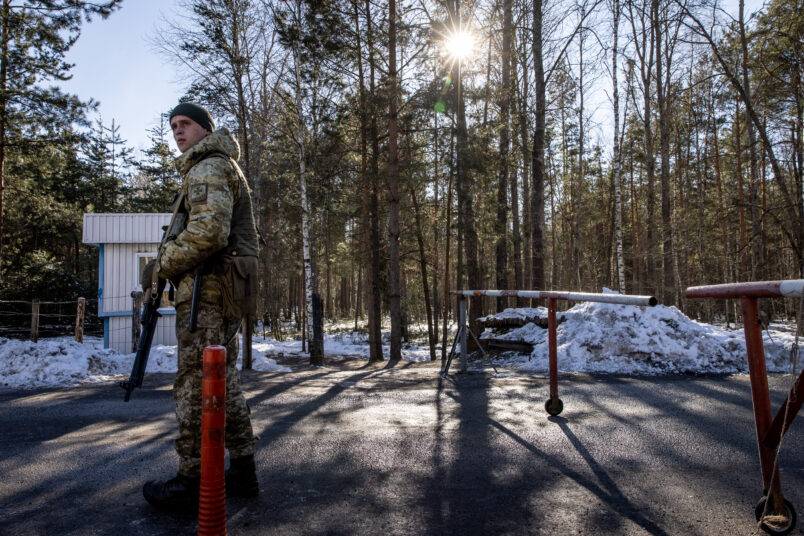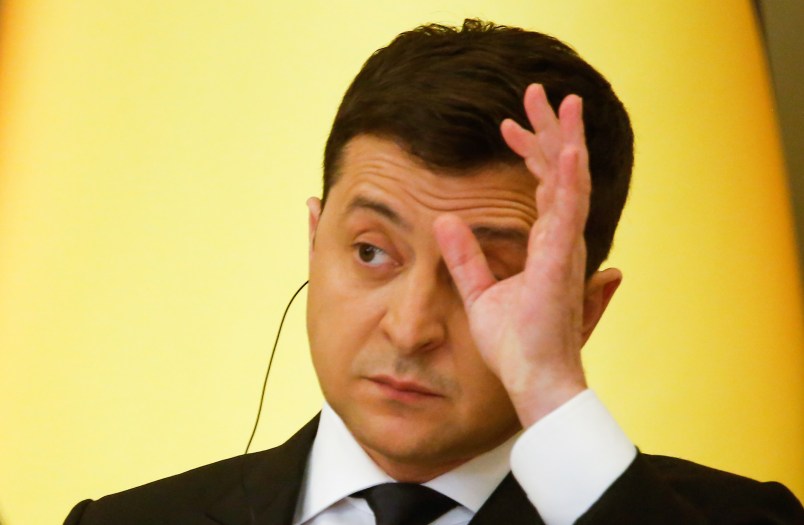On Sunday evening, Ukrainian member of parliament Oleg Voloshyn got into his car and set out for Belarus.
“Those who flee mostly choose warmer countries,” Voloshyn told TPM, saying that he was headed to Ukraine’s northern neighbor, where thousands of Russian troops are stationed, to discuss “policy issues” that he declined to specify.
Voloshyn added that he had been in Paris last week, and Hungary before. “I travel a lot,” he said.
An old associate of Paul Manafort’s who was recently sanctioned by the U.S. government for allegedly being part of a Russian plot to overthrow the current government in Kyiv, Voloshyn’s departure comes with massive tension in the background.
U.S. intelligence officials reportedly expect an invasion to occur this week, while new reports say that Russian artillery have assumed firing positions along the Ukrainian border.
Ukrainian President Volodymyr Zelensky addressed his country on Monday, mentioning media and foreign intelligence reports saying that “February 16 will be the day of the attack.”
“Today is not only the day of those in love, but of those in love with Ukraine,” he added, going on to declare Feb. 16 as an official “Day of Unity.”
The picture is one of raw tension, with foreign embassies departing and videos of Russian tanks approaching the border continuing to spread across social media networks.
But with Russian troops having not yet made a new incursion into Ukraine, the question remains: is this just for show? Or is this for real?
“The Russians are purposely trying to create a sense of tension,” Steven Pifer, a former U.S. Ambassador to Ukraine, told TPM. “From the Kremlin’s perspective, the ideal outcome is that Kyiv starts making concessions now, NATO and the West start making concessions in the face of the threat.”
It’s not a new idea in the crisis.
In November, Russian President Vladimir Putin discussed the use of tension as a tool with a group of Russian diplomats.
“Our recent warnings have indeed been heard and are having a certain effect: tensions have risen,” Russian President Vladimir Putin said. “It is important for them to remain in this state for as long as possible.”
Military analysts say that Russian troop movements look like — and are designed to look like — final preparations for a large-scale invasion.
“This is a force to conduct a major operation, a major invasion of Ukraine — the kind you’d need to take Kyiv, occupy it, and stay there for awhile,” Jeff Edmonds, an analyst at CNA and former Russia director on the National Security Council, told TPM. “It’s a very big force to deploy just to signal somebody.”

Many of the videos of Russian troop movements analyzed by open-source researchers have surfaced on TikTok, though their provenance is also hard to verify. TPM contacted several accounts that posted videos of Russian troop movements.
“It’s my country, my motherland,” replied one Sevastopol-area TikTok user as he refused to discuss a video with TPM that shows a field of Russian tanks next to a highway.
Others have described the videos themselves as a form of psychological warfare.
“This is a well-planned psychic attack, calculated down to its smallest details, that should elicit panic in Kyiv,” wrote Vladimir Pastukhov, a political scientist at University College London, last month.
Pastukhov likened videos of assembling Russian troops to a scene from the classic Soviet movie “Chapayev,” in which the White Russian army stages an intimidation attack on Soviet defenders through an aggressive march, causing some of the Red Army to flee.
Many Ukrainians regard Putin’s pressure campaign as directed towards strong-arming Ukraine into implementing the Minsk-II agreements, the peace deal that has governed the conflict since the last major hostilities in 2015. Per the agreement, Russia wants Ukraine to amend its Constitution to give its breakaway regions domestic autonomy — a move that, Ukrainian negotiators say, would give Russia an internal veto on Ukraine’s NATO and EU aspirations.
Nobody, not even Zelensky or top Biden administration officials such as National Security Adviser Jake Sullivan, seem completely certain about what will come next.
Putin met with Russian Foreign Minister Sergey Lavrov and Defense Minister Sergey Shoigu on Monday in a surreally staged meeting. Shoigu said that exercises had finished, while Lavrov advised Putin that diplomatic options were still on the table.“There’s always a chance,” Lavrov said.
“Good,” Putin replied.
To Shoigu, Putin replied, “good, thank you,” before adding: “we’ll discuss in more detail” as the cameras turned off.
Ukrainska Pravda, a Ukrainian news outlet, reported on Monday that 23 members of the country’s parliament — including Voloshyn — had left the country in recent weeks, and that dozens of oligarchs and businessmen had done the same.
Zelensky, a comic performer who became a politician, demanded in his speech that representatives of the Ukrainian government who are currently abroad return to Ukraine within 24 hours.
“The people of Ukraine have entrusted you not only to manage the state, but to protect it. It’s your main responsibility in such a situation — to be together with us, with the Ukrainian people,” Zelensky said. “I now demand that you return to the motherland within 24 hours and stand shoulder-to-shoulder with the Ukrainian army, diplomats, and people!”
Voloshyn, one such Ukrainian official currently outside of the country, dismissed the tension to TPM, writing, “looks like a big orchestrated performance.”
Voloshyn did not reply when TPM asked who, he believed, was performing.







May you live in interesting times.
Putin lies about so many things, whose to say this isn’t just one more lie.
He’s using the Minsk agreement as just one more excuse to cover up being the thug that he really is. He’ll have another when this one fails.
I wonder what the Ukrainian statue says about confiscating abandoned property?
Minsk-II, the russian version, is about the best solution for Putin.
Hard to be an occupier of a country, much easier to have a Belarus or Kazakhstan situation, where a friendly puppet government beholden to you keeps the peasants in line.
Minsk-II, the russkie interpretation, would be ideal because:
russia claims it means that Luhansk and Donetsk would become independent “states”, with veto power over the federal level decisions, so no way for Ukraine to ever join NATO so long as russia maintains its grip on those provinces.
a bonus of (1) above, the mere implementation is likely to get the government tossed out, which opens up an opportunity to install a friendly puppet.
Moldova Tourism Authority: “Come For The Warmer Sub-Freezing Winters, Stay For The Arbitrary Detentions And Torture!”